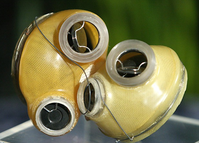








An artificial heart is a device that replaces the heart. Artificial hearts are typically used to bridge the time to heart transplantation, or to permanently replace the heart in case heart transplantation is impossible. Although other similar inventions preceded it going back to the late 1940s, the first artificial heart to be successfully implanted in a human was the Jarvik-7 in 1982, designed by a team including Willem Johan Kolff and Robert Jarvik.
Paul Winchell invented an artificial heart with the assistance of Henry Heimlich (the inventor of the Heimlich Maneuver) and held the first patent for such a device. The University of Utah developed a similar apparatus around the same time, but when they tried to patent it, Winchell's heart was cited as prior art. The university requested that Winchell donate the heart to the University of Utah, which he did. There is some debate as to how much of Winchell's design Robert Jarvik used in creating Jarvik's artificial heart. Heimlich states, "I saw the heart, I saw the patent and I saw the letters. The basic principle used in Winchell's heart and Jarvik's heart is exactly the same." Jarvik denies that any of Winchell's design elements were incorporated into the device he fabricated for humans which was successfully implanted into Barney Clark in 1982.
On December 12, 1957, Willem Johan Kolff, the world's most prolific inventor of artificial organs, implanted an artificial heart into a dog at Cleveland Clinic. The dog lived for 90 minutes.
In 1958, Domingo Liotta initiated the studies of TAH replacement at Lyon, France, and in 1959–60 at the National University of Córdoba, Argentina. He presented his work at the meeting of the American Society for Artificial Internal Organs held in Atlantic City in March 1961. At that meeting, Liotta described the implantation of three types of orthotopic (inside the pericardial sac) TAHs in dogs, each of which used a different source of external energy: an implantable electric motor, an implantable rotating pump with an external electric motor, and a pneumatic pump.
In 1964, the National Institutes of Health started the Artificial Heart Program, with the goal of putting a man-made organ into a human by the end of the decade.
In February 1966, Adrian Kantrowitz rose to international prominence when he performed the world's first permanent implantation of a partial mechanical heart (left ventricular assist device) at Maimonides Medical Center.
In 1967, Kolff left Cleveland Clinic to start the Division of Artificial Organs at the University of Utah and pursue his work on the artificial heart.
In 1973, a calf named Tony survived for 30 days on an early Kolff heart.
In 1975, a bull named Burk survived 90 days on the artificial heart.
In 1976, a calf named Abebe lived for 184 days on the Jarvik 5 artificial heart.
In 1981, a calf named Alfred Lord Tennyson lived for 268 days on the Jarvik 5.
Over the years, more than 200 physicians, engineers, students and faculty developed, tested and improved Kolff's artificial heart. To help manage his many endeavors, Kolff assigned project managers. Each project was named after its manager. Graduate student Robert Jarvik was the project manager for the artificial heart, which was subsequently renamed the Jarvik 7.
In 1981, William DeVries submitted a request to the FDA for permission to implant the Jarvik 7 into a human being. On December 2, 1982, Kolff implanted the Jarvik 7 artificial heart into Barney Clark, a dentist from Seattle who was suffering from severe congestive heart failure. While Clark lived for 112 days tethered to an external pneumatic compressor, a device weighing some 400 pounds (180 kg), during that time he suffered prolonged periods of confusion and a number of instances of bleeding, and asked several times to be allowed to die.